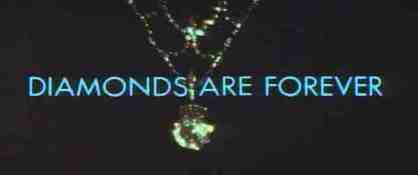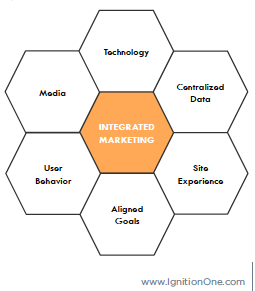True Integrated Marketing: The Holy Grail?
September 20, 2013
Recently, I had the pleasure of meeting the IgnitionOne team during a employment pitch. I have managed or worked with over 15 digital agencies over the years, and most of them try and promote a vision that drives their brand identity. IgnitionOne was one of the rare companies that didn’t just promote their vision, they LIVED IT! I felt compelled to share it with my fellow marketers.
As some of you know, I am a very passionate marketer that for years has strived to break through the silos that digital marketing inherently creates. White Dog Consulting. I have attempted to bridge the communication gaps to in an attempt to cohesively focus my clients’ marketing strategy. I have written time and time again how companies tend to develop its digital strategy using resources that are specialized. What usually happens is that these specialties tend to focus too narrowly and rarely does it cross over to other “specialties”. Whether its SEM not working with SEO or Radio not looking at Search, or other silo’ed media, marketing departments loose tremendous efficiencies by not working in consort.
I have spent 13 years attempting to create symphonies for companies that have chairs full of talented instrumentalists. The only tool that I had at my disposal was the music or in my case the Data. I would analyze data, cross reference it, append, used tools like regression, all in an attempt to integrate strategy while educating the players on the impact that each player contributes. Aligning people, media, and business goals with overall company business goals.
Using this approach, I found that the biggest challenge has never been getting people on board with the strategy. The real challenge surfaced in how it was communicated. For with each specialty, came unique operational languages that seemed to be isolated and dedicated for its own end goals. Not surprisingly, Call centers/PPC/SEO/Radio-TV/ etc. used unique systems and tools combined with nomenclature that were developed for managing efficiencies within their own channel and seldom translated cross functionally. Close rate/Sales rate, dispositions/shopping cart abandon, universe/search volume, etc.
My broad marketing knowledge has ironically given me my own narrowly focused specialty as a result – Integration through Translation. Through the years, I have developed the skills to act as a liaison between linear personalities like IT and creative minded left brainers in Marketing…or helped pair free wheeling search SEO scientists who are proactive experimenters with laser focused SEM jockeys who eat response data on a minute by minute basis.
For years, I preached and evangelized this philosophy, but never have I seen someone put down on paper this philosophy in an eloquent way. Until now that is. Will Mariloff, the founder and CEO of IgnitionOne, did the heavy lifting for me.His white paper, The Integrated Digital Marketing Playbook, is far to good to not share with the masses. It is a fantastic attempt at breaking down the evolution of digital marketing by exposing the elephant in the room while using actionable data analytics to shed light on the power of how to integrate marketing channels into one fluid strategy.
Will attempted to answer the tough questions like:
- What are the central challenges to achieving integrated digital marketing?
- How do I set up my organization to facilitate and take advantage of integration?
- How do I centralize tools, data and measurement to achieve integrated marketing?
- What is the payoff for integrating my marketing?
So again, thank you Will for a masterful synopsis on how organizations can harness true integration of their marketing strategy using actionable analytics and a little people skills! Great job!
Throw Out Your Digital Playbook, The Game Has Changed!!
January 17, 2012
I have notice a rising trend in my discussions about digital strategy among my peers. The trend is that we all feel that we are in the middle of a tectonic shift in how we define digital strategy. In the past, strategy has be driven by a balanced approach to its execution. When new technologies would emerge, we would simple gradually add them to the mix and as they matured they would receive and increase focus and inclusion to the existing strategy. In other words, this strategy was an “add on” approach. However, Social Business and Mobile Media have made it clear that this “add on” strategy is obsolete. In fact, I believe that we need to fundamentally reconstruct our digital strategy starting from a completely different viewpoint. A point at which, Social and Mobile are becoming perhaps the dominant channel in which all other media should integrate into. As opposed to the way of the past – Just add mobile and social into the current approach.
First let’s talk about what I believe is the most pressing new direction, Social. Social media or business (as it is starting to be called) is changing the way consumers interact with a brand. Twitter, Facebook, Google + just to name a few are empowering consumers to interact with their peers in terms of relating to a brand. It is no longer a simple “push pull” environment. Search algorithms have now prioritized search based on your social network, Bing/Yahoo/Facebook and Google +. So gone are the days of “He who has the most money wins!” Today, if a listing is both ranked high organically as well as PPC they may not get consideration if someone in that consumers network doesn’t “like” of Google + it. If there are 10 links that show up on my search page, I no longer go to 1,2 or 3. I look for at Google + symbol first, and then I look at rank. Subsequently, it is an environment in which a business has to market “like” a consumer markets themselves to their peer group. A consumer is building personal networks of people that they respect and who in turn respect them. They are building relationships through reputation or even communal belief systems. For a brand this is such a foreign way to think.
Now a company has to create demand by reaching prospects through other prospects using a strategy that encourages interaction with its brand in order to create a relationship. That relationship can translate and propagate through individual networks rather quickly. The problem is that we don’t really know what that brand image will be definitively because it is unique to the individual relationship and their social network. In some ways, Consumers are defining what your brand is to them. Instead, of a company telling consumers what they want them to think of their brand! So if this is true, then all components of your digital strategy should include or be hyper cognizant of the social implications. Even components that we rarely think of as true demand generators will start to come further to the front of our strategies. For example, CRM strategy is now a full on demand generator! How your customers experience your brand is now incredibly important since they are powerful influencers in terms of the validity of your branding and marketing image. CRM systems now need to integrate social media into how they grade or track customer interaction and subsequent behavior. Are you starting to see how BIG this starting to get?!
Then next major shift in how we think as marketers involves our Mobile strategy. When smart phones were first introduced, most of us slowly developed Mobile sites as a low priority backup plan. We were still aggressively trying to work on tradition User Experience and busy optimizing for search (sometimes at the expense of the consumer).  Now the tide has turned and boy has it turned! Smart phones are everywhere and tablets are replacing laptops at a record pace! However, if you quizzed most marketing professionals on where mobile was prioritized, it would be moving up the ranks but still not the top priority. I say this is a strategy that will come back to bite you and cost you an incredible amount of time and money if you are not aggressively optimizing your strategy with Mobile at the top of your list. Not only that, but you should be optimizing for Social Media on Mobile second! Just to further muddy the waters, Interactive Web Ready TV’s are flooding the market now. Experts believe that they interact with a site more like tablet readers than computer users.
Now the tide has turned and boy has it turned! Smart phones are everywhere and tablets are replacing laptops at a record pace! However, if you quizzed most marketing professionals on where mobile was prioritized, it would be moving up the ranks but still not the top priority. I say this is a strategy that will come back to bite you and cost you an incredible amount of time and money if you are not aggressively optimizing your strategy with Mobile at the top of your list. Not only that, but you should be optimizing for Social Media on Mobile second! Just to further muddy the waters, Interactive Web Ready TV’s are flooding the market now. Experts believe that they interact with a site more like tablet readers than computer users.
Now be honest, look at your digital strategy for 2012. Is social media and mobile in the top 5 of priorities? Unfortunately, most of you will say “nope”, but we are really thinking about it. Stop thinking and start doing. Any direction towards a changing market is a good direction at this point.
The Dachis group has a slightly different take on the impact of Social and Mobile here. I highly recommend you check out Dion Hinchcliffe‘s perspective. Fascination read.
Good SEO just may be right before under your nose…
August 8, 2011
Drowning in Twitter, Someone Throw Me a Line!!
July 22, 2011
Ok I have to admit it – In the beginning I never got the use of Twitter. I found it to be a colossal waste of time and a little bit narcissistic. Why would anyone care about the fact that I was “going to the gym” or “listening to Dave Mathew’s Station on Pandora”. “Flying to Seattle and I’m laid over 2 hours” ~ I mean really what benefit would these facts of life give me or anyone…
I have always been brought up to turn my back on popular culture. Independent thinking and personal choice should influence your decisions, right? You see, to me I see the puppet masters behind Oz’s curtain when it comes to making of a buck by the manipulation of the ignorant public – a school of mindless fish with debit cards swiming in the direction that everyone does. Every move, every turn, every jump is made by following the collective of school. Or in terms of people, we too have come to blindly follow things just to make ourselves feel included and part of a collective that we believe is bigger and better than us. Informed opinions are become quickly replaced by what the media tells us what is likable. Depressing?
This is never more evident than in the music industry. I have to chuckle when I think of 10 record (marketing) executives sitting around a table running a SWOT analysis on the likes of a Brittney Spears – they use the school of fish mentality to easily fleece us of our money all the while diluting the very product that feeds them. Let’s face it, there are countless Brittney’s out there – marginally talented people with pretty faces and figures. Behind them they have a hidden “marketing machine” that can transform them – through seasoned writers, image specialists, veteran backup bands, voice synthesizers, and plenty of lip syncing – into Gods/Goddess of Popular Culture! Since we are a culture of want and not need it easily plays into a marketers hands. To keep the analogy alive, it is quite like “shooting fish in a barrel”.
And it is at this point that other true musicians like, Jerry Garcia or Bob Dylan or Jimi Hendrix’s and numerous others, rolled over in their graves. (Sorry Bob I know you’re alive but Pop Culture people think you aren’t)
Stepping proudly down from my pulpit of independent punditry, I squared up my cynic hat and proudly ignored all the Twittering about Twitter at every media outlet that surrounded me. Every business convention regardless of the medium was saturated with talk of Twittering. It seemed everywhere – in every newscast, by every celebrity, by the water cooler, overhearing it at the local pizza joint!!! We all knew it existed and we all debated its use. God get over it already! Oprah just started Twittering and Ellen DeGeneres just mutually followed MC Hammer! I guess it is worth a free bucket of grilled KFC (sacrilege by the way)
Really is this a tool that have any use in my busy life? Please, do tell…
Then it happened, Dan McCarthy (my boss and CEO of NCI) launched a ground breaking social media project called Project Massive Network.(www.apartmentfinder.com, http://www.therealestatebook.com) Simply put, he was trying to reach into our warm and comfortable world of mass publishing and shake us awake so that we can realize that there is an oncoming wave of customer opinion is reshaping how we all will do business in the future. Tools of empowerment like Facebook, Bebo, and Twitter to name just a few, were conduits for consumer to lead this marketing revolution. After all, shouldn’t we expect that if we ignore this rising tide of change then your company will become…errrr…well umm – Chrysler GM. On a side note, this is (was) a company that drowned in its own ignorance, by turning its eyes away when faced fact that Japan changed the entire world model and subsequently the economics of car building.
Much like Chrysler, I was still stubborn to change but now I forced by work to jump back into just another thing the people say that keeps me connected to the world. Thus, I again stepped gently into the murky and uncomfortable waters of Twitter. Immediately, I felt vindicated the first day. This” Twitter thing is useless!”, I proudly exclaimed to myself. Disjointed conversations and a lack of anything important to say in 140 characters or less, I still wasn’t impressed.
Then a funny thing happened….someone peeked my interest on a topic.
- jburslemReading about the “catastrophic binge on overpriced real estate and reckless mortgages” http://bit.ly/Rtu3S
Innocently, I clicked on a “tinyurl” and was surprised that I it dug much deeper than just 140 characters on a subject that was surprisingly interesting to me. Dumbfounded yet intrigued, I felt that surely this has to have been a fluke. Temporarily motivated, I began to wade a little deeper in these unfamiliar waters with a renewed interest. Curious, I then jumped into the task of “following” my friends and coworkers…boom another hook to cool information, bang hooked on something again. Something foreign was taking shape.
Then it hit me – a “Twitterephiny” if you will (since every developer feels the need to make a cool word out of twitter, I felt like doing the same.). With every follower that I followed, with every follower following me, I was building my own community of like interests. My own school of fish that had similar likes and interests. This school of fish that was willingly influenced because it was a community bonded to each other by social interaction. This wasn’t the blind and ignorant collective that I originally thought it was. It was just the opposite. Yes it is a collective but it is more than that, it is a collective of both the followers as well as the followed. We are influencing each other willingly by using a media tool that is social.
“Twitterenlightened”! I now understand that we are not a “school of fish”. On the contrary. we are really an “army of one”. Mutual connections and realtime information that is relative to my life is extremely important to me. Thanks Dan @danielrmccarthy and Todd @TDubner, for forcing me to eat a mouthful of crow.
Wow, I am glad I got that off my chest…I have to go now, American Idol results are in.
(it is purely human behavioral research – get over it)
This is my first post so be gentle! Regardless, this subject is a great one. It speaks to the changing world of marketing online and how Social Media is changing just how we think about old school marketing. I think it is a solid first start…tell me what you think?
online and how Social Media is changing just how we think about old school marketing. I think it is a solid first start…tell me what you think?
I was at the Silverpop Customer Conference (ESP – Email Service Provider) a couple of days ago and the CEO Bill Nussey summed up what I consider to be the modern definition of brand in just a few sentences. Trust me, I was quick to paraphrase it in 140 letters and tweeted it to the masses. Here it is:
“Today, a co.(company’s) Brand is established by collective opinions and not old school push media. Engagement is the cornerstone of future mktg.”
Old school TV, Radio, Print marketing is centered around one way communications in a world that now is relying on two way peer influence. Then I read a blog post from Dan McCarthy, the CEO of Network Communications Inc, that further strengthened my opinion. Incidentally, NCI is the parent company of print and online publications like The Real Estate Book, Apartmentfinder, Unique Homes, and 20 other variaous brands. The title of the blog was Century 21 shifts its marketing focus to social media to re-enter the conversation. 
“Century 21 recently launched a Communities feature on its web site that is the hub of their social media strategy.We developed C21 Communities with the goal of opening up an online conversation with the consumer,” said Thorne. “Just as CENTURY 21 was the first national real estate franchise to advertise on television, we will continue to take a leadership position as we expand our capabilities in the social media space.”
Established brands are desperately trying to connect with prospects and customers in order to make good on their projected image. Take a look at Ad Age’s The Top Slogans of the Decade. After all, aren’t they just micro statements of what image a company is trying to push?
- Diamonds are forever (DeBeers)
- Just do it (Nike

 )
) 

- The pause that refreshes (Coca-Cola)
- Tastes great, less filling (Miller Lite)
- We try harder (Avis)
- Good to the last drop (Maxwell House)
- Breakfast of champions (Wheaties)
- Does she … or doesn’t she? (Clairol)
- When it rains it pours (Morton Salt)
- Where’s the beef? (Wendy’s)
What happens if you are a brand that has little awareness or if new to the market place? Now you have an incredible opportunity to let the public create a customized image based on participation and awareness. Social media creates a unique opportunity to let the masses establish an image by engagement at relatively little cost Consider the shear number of users on Twitter and Facebook. According to Mashable, Compete’s numbers for April show that Facebook ( ) has grown from 91,000,000 to 104,000,000 unique visitors, a healthy 14.35% increase from March. Twitter’s number of unique visitors has grown from 14,000,000 to 19,000,000, which is 38,56% growth.
) has grown from 91,000,000 to 104,000,000 unique visitors, a healthy 14.35% increase from March. Twitter’s number of unique visitors has grown from 14,000,000 to 19,000,000, which is 38,56% growth.
Now take it to the next level. I believe that if you are a company that has a perceived high risk product and low brand awareness then social media can play a pivotal role in establishing the trust needed to influence behavior. Gord Hotchkiss summarizes it best in his blog about Satisficing, Bounded Rationality and Search. Take a look:
If risk is high and brand identification is low (buying software for the company), there is a high likelihood that search will be used extensively. If risk is low and brand identification is high (i.e. buying a soft drink or a beer) there is almost no likelihood that search will be used. In this case, the two factors usually work inversely to each other. Emotional enjoyment isn’t as directly tied to search activity. We will do as much (or as little) searching for a purchase that will give us great enjoyment as for those that won’t.
Whether it is home sales, apartment leasing, or even home design and improvement, people connect with the end product first and the resource a distant second. After all, these purchases are high risk decisions that require establishing a considerable amount of trust to promote action.

The way you thought about traditional branding is dramatically changing with the advent of social media.
Arguably, some people say that marketing is just a sales job that just focuses on mass media influencing the sale by indirect or direct positioning. After all, both professions use the same techniques to try and get a sale. Consider a sales persons cycle: Find the right prospect, establish rapport, ask for the sale, overcome the objections, and then close.
Similarly, in marketing we establish the establish rapport (trust) based on how we construct the message to a highly profiled prospective audience. Then we address potential objections by reinforcing our message with copy and creative to attempt to connect to an emotion. The better the rapport (trust tied to established brand) the easier it is to ask for the sale. After all, establishing a rapport helps a consumer identify with the brand and encourages a behavior that they are actively participating in.
With the introduction of Social media, it is finally giving traditional marketers the ability to become front line sales people that can react based on the direct and indirect communication surrounding the transaction. We now have the ability to listen and then customize the message to help the prospect feel good about making a decision.
High risk – low brand association marketing becomes more about facilitation of comfort with the product purchase and less about the parent brand image. Information and engagement connects the buyer with the brand of their choice based on personal empowerment by participation (individual home, apartment, home improvement) and is supported by the ability of the media resource to build trust by peer influence and unbiased and unfettered access to information that promote individual choice.
Embracing social media and fully incorporating it in the site architecture critical to the facilitation of this personal branding. It is especially critical when it comes to commoditized web sites like aggregators of data or information.
Today as marketers we need to completely rewire our way of thinking. The days of push media is quickly loosing the weight that it has been used to and we need to become sales people again in which we garner sales through listening again.






